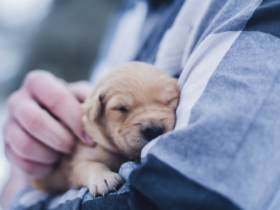Bringing home a new puppy is exciting … and a bit stressful. There are a lot of things to consider, including where the pup will sleep, what they should eat, when to start training, and how to get them to go potty outside. But of all the essential things you must plan to do when you add a new canine companion to your family, establishing a regular schedule is one of the most important.
Just like with our human babies, dogs need a routine. They need to feel confident in knowing when things will happen, like when they will get fed, when they will go outside and get exercise, or when it’s just time for play and fun. Providing your dog with a consistent schedule will help them in myriad ways including potty training, skills training, and behavior development. It can seem overwhelming to consider creating an effective schedule for a new pup when you might already struggle with your own, but luckily it’s easy to do with this simple guide.
Starting a Schedule for Your Puppy
First things first. Consider your own schedule. When do you eat breakfast? What time do you leave for work in the morning? When do you get home and eat dinner? Your new puppy’s schedule should mirror your own. Feed them when you eat, play with them when you get home from work, and give them exercise when you are most likely to do it yourself. But keep in mind; it may not feel like the end of the world for you when you miss a day of fitness or spend too much time on your laptop, but it will feel terrible for your pup. Puppies cannot go a day without play sessions or romps around the neighborhood. For your new dog, a daily schedule really does mean every.single.day.
If you find it helpful to have a calendar on your fridge that notes your week’s important activities, make one for your pup too. You will have to make adjustments in your own routine to accommodate the needs of your new furry family member, but when you are consistent and deliberate about it the routine will fall into place easily for the both of you.
The sooner you implement a schedule and routine for your puppy the better, as this consistency will help your pup adjust to their new life with you.
5 Puppy Daily Routine Elements to Consider
1. Feeding
While puppies grow they eat … a lot … and the amount they eat will change as they age. Most pups under the age of 5–6 months need to be fed three meals a day. To make it easy, feed them at the same time you eat breakfast, lunch, and dinner. Don’t forget to offer lots of clean, fresh water at mealtimes and throughout the day as well.
2. Pottying
Depending on their age, pups need to potty every 1–4 hours, with younger pups needing to go most often.
To help with potty training, puppies should have consistent times throughout the day that are set aside just for going outside. And always remember to let your pup outside the moment you let them out of the crate!
These are the five key times in their day when a dog must be let outside to potty:
- After resting/sleeping
- After play sessions
- After eating and drinking
- Before going to bed or in the crate
- Before and after training sessions
And don’t be surprised if your puppy needs to go potty again shortly after he went out. Pups don’t always totally eliminate each time they go. If your pup didn’t pee when you let him out because he was too busy chasing his buddy or trying to eat the leaves off your bush, then you will find (much to your chagrin, I bet) he needs to go as soon as you let him inside. Just be patient and give him plenty of opportunities to get it right.
3. Enrichment and Playtime
Making sure you provide your pup ample enrichment is critical to their healthy development. Pups that are denied significant play and enrichment are more likely to have anxiety, to be fearful and lack confidence, to be socially underdeveloped, and to have behavioral concerns in adolescence.
Plan out times during your day where your pup gets your undivided attention. Spend time before you leave for work playing with toys or doing some basic training; this will help ease them into your departure. Leave out some great interactive toys or puzzles for them while you are gone to eliminate boredom. The moment you come home each day, go outside and play tug or throw their favorite ball. After dinner take them for a good walk and explore your neighborhood.
Play times are great moments that your pup desperately needs, but they should never be overly long or adurouse. Think short and sweet: Your 3-month-old puppy cannot handle more than 15–20 minutes of significant activity at any given time (despite what it might appear) or else they will experience overarousal and overstimulation. Be sure that any time your pup engages in mental and physical stimulation that they have the opportunity to rest undisturbed afterwards (and get a potty break!).
4. Socialization and Learning Time
Of all the things a puppy really needs to grow into a happy adult, socialization is probably number one. Socialization is the surest way to prevent behavior issues later on and it is the thing dog owners tend to overlook (avoid that common mistake!).
Canine socialization doesn’t mean just taking your dog to the dog park or going to a few puppy classes. Likewise, dog owners must be especially sure they are never flooding their new puppy with overwhelming stimulation, as that will only lead to issues later on. Socialization is a systematic process in which you gradually and thoughtfully expose your puppy to the world around them, always at their own pace and always in a positive and safe manner. Understanding how your dog learns (Surprise! They learn just like you!) is a must, too.
Each day should be full of socialization opportunities that can include teaching them basic skills with positive reinforcement and going to puppy training classes, investigating the environment around them, taking trips to the vet, going on walks on leash, playing around other dogs and new people, and experiencing the sights and sounds of everyday life with you. Again, short and sweet is the key.
5. Rest
At times, it will feel as if your new puppy will never sleep, and then suddenly they’ll seem to do nothing but sleep. As their body grows and adjusts so does their sleep schedule. Don’t assume that your high-energy puppy doesn’t need a nap either! Pups that do not rest are more likely to turn into little grouchy sharks (your hand will learn this quickly with each nip), so always make sure to listen to their body language and end play time before it’s just too much.
Plan on quiet times when your pup can rest without distractions from anyone else in the house. Scheduled short naps in their crate or kennel is a good way to get crate training started off on the right paw, ensuring that it becomes a treasured safe space, too.
When it comes to bedtimes, you may find your pup will quickly follow your lead and go to bed when you do. Just remember to always let them potty again right before you both close your eyes for the night.
It will take a few weeks or more for you pup to get used to things and begin to feel at home. The quicker you implement a schedule and stick to a daily routine the faster your pup will adjust to his life with you.
Example Puppy Daily Schedule Chart
:max_bytes(150000):strip_icc()/Building-a-Routine-for-your-puppy-06-2000-b747f59727c247b6a9ba5f5683799a3e.jpg)




:max_bytes(150000):strip_icc()/puppy-on-bed-200460053-001-2000-54de28e1428549db87eca99653e1d289.jpg)
:max_bytes(150000):strip_icc()/signs-youre-not-ready-for-a-dog-dpddm-BP7325-2000-106a5fc1f1254a318e2bdf23b1521612.jpg)
:max_bytes(150000):strip_icc()/bedlington-terrier-lying-rug-1186353094-2000-0253d70f30a74f08a0b82354b0226d05.jpg)
:max_bytes(150000):strip_icc()/cat-shampoo-60faa26684d34026a9b482073b87d4c6.png)
:max_bytes(150000):strip_icc()/cat-trees-for-large-cats-2000-1ec2ca7fb1be49b78244096f5c2367b2.jpg)
:max_bytes(150000):strip_icc()/jodi-and-freya-resuce-dog-2000-85c44a65993b40668a6d142728305d86.jpg)
:max_bytes(150000):strip_icc()/how-to-rehome-a-dog-1322871684-2000-efe00c0e8bf8427d9d98b2b47ee58cfd.jpg)
Leave a Reply
View Comments